Scaphoid Bone
Brüche (=Frakturen) des Kahnbeins enden häufig mit signifikanten funktionellen Verlusten, Arbeitsunfähigkeit für Wochen und langfristiger Abstinenz von sportlichen Ausgleichsaktivitäten. Hauptprobleme rund um die Kahnbeinfraktur sind immer noch die Diagnose, aber auch andere Komplikationen wie posttraumatische Schmerzen, Funktionsverlust, verzögerte Frakturheilung bis hin zur Pseudarthrose (=Nicht-Heilung des Knochens).
DIAGNOSIS
Diagnosis is carried out through a clinical examination and evaluation of the circumstances of the accident. Such accidents often involve falling onto an outstretched hand, over-stretching the wrist backwards. The area of maximum tenderness is just above the snuff-box, the hollow formed by the two extensor tendons of the thumb. After a short period of time, a hematoma, or bruise, often emerges at the site. However, symptoms are often not particularly pronounced, causing the fracture to not be noticed and symptoms simply overlooked. This is a great disadvantage, as lack of treatment often leads to pseudoarthrosis (see below), and all its unpleasant consequences.
For accurate diagnosis, an X-ray including four images of the carpus (Image 1a) is absolutely imperative. In the event that clinical symptoms of a scaphoid bone fracture are present but cannot be confirmed radiologically, Dr. Gäbler recommends an MRI (Image 1b). An alternative to the MRI would be to place the injured hand in a cast and repeat the X-ray after 10 days.
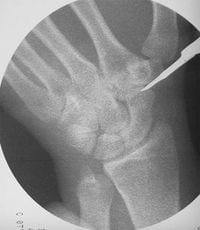

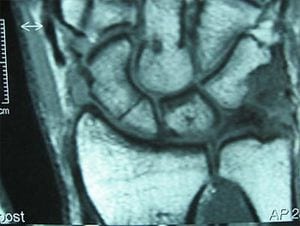
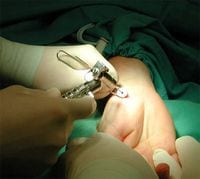
TREATMENT
Many hospitals still just put the injured wrist in a cast. The thumb is often included in the cast despite it having been proven including the thumb in a non-displaced scaphoid fracture has no benefits. A correctly positioned forearm cast suffices for a non-displaced scaphoid fracture. Immobilization by cast should last eight weeks.
Es ist zwar generell anerkannt, dass Kahnbeinfrakturen üblicherweise innerhalb von acht Wochen geheilt sind, allerdings kann die knöcherne Heilung auch 12 bis 16 Wochen dauern – und manche Frakturen sind trotz dieser langen Gipsfixierung nicht geheilt – und es kommt zur Pseudarthrose (=Nicht-Heilung mit der Bildung eines Falschgelenkes)
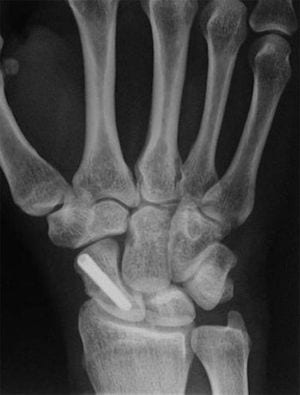
Pseudarthrosis of the scaphoid is a serious problem that usually ends in severe arthrosis of the wrist, severe pain and weakness, and requires surgical procedures that go as far as stiffening the wrist. Most such cases of pseudarthrosis occur as a result of inadequate immobilization with a cast. However, pseudarthrosis also often arises when an injury to the scaphoid is not detected. Scaphoid fractures primarily occur in young active individuals as a result of falling onto the wrist (for example when cycling, in-line skating, skiing, or quite simply by falling on the street). To allow a scaphoid fracture to heal, patients must be immobilized in a cast for weeks or months, therefore often prevented from working and, of course, athletic activities.
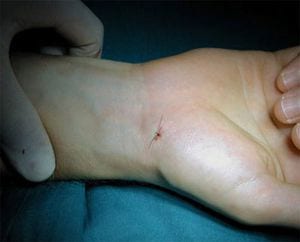
AN ALTERNATIVE: A PERCUTANEOUS OPERATION
An alternative to this is to treat the patient using a very gentle (minimally invasive) operation method. For this procedure, a screw is inserted through a tiny incision, stabilizing the fracture. Patients operated on this way do not require a cast and are fully able to work and do sports after four weeks.
Together with the University of Edinburgh, Dr. Gäbler carried out a scientific study on the topic, which was published in a top journal:
McQueen MM, Gelbke M., Wakefield A., Will E., Gaebler C.
Percutaneous Screw Fixation Versus Conservative Treatment for Fractures of the Wrist of the Scaphoid: A Prospective Randomized Study
J Bone Joint Surgery Br (2008) 90: 66 – 71
This study used scientific methods to show with complete objectivity that this surgical method is far superior to long-term immobilization in a cast. There were no significant complications as a result of the operation. Patients who had been operated on were able to play sports again after only five weeks and were also fully capable of returning to work. Patients who had only been immobilized in a cast required an average of eight weeks before returning to work and an average of 14 weeks before being fully able to play sports. Moreover, three patients in the group that were not operated on contracted pseudarthrosis, which then had to be operated on after 16 weeks of wearing a cast.
More questions?
Our experts are happy to help you
Just give us a call!




